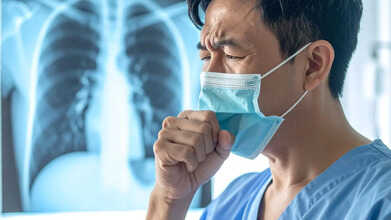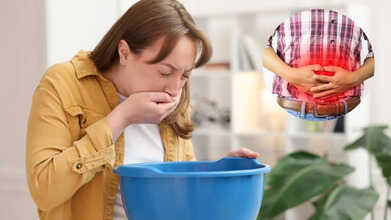- Health Conditions A-Z
- Health & Wellness
- Nutrition
- Fitness
- Health News
- Ayurveda
- Videos
- Medicine A-Z
- Parenting
Daily Skincare Guide: Natural Remedies To Balance Oily And Acne-Prone Skin

Image Credit: Canva
The skin is an outward reflection of our internal health. Dull skin, for instance, may indicate dehydration, a lack of essential nutrients, or an inconsistent skincare routine. As the most visible organ, the skin also provides insight into the health of the body tissues it protects. It's more than just an aesthetic aspect—it’s a window into overall well-being. Disorders of the gut, blood, hormones, and even the heart can manifest as skin issues, such as rashes.
Ayurveda has long emphasized the importance of skincare. In today's fast-paced world, a proper skincare routine is indispensable, not only for physical health but also for mental well-being. While modern skincare offers a plethora of products, many come with side effects. Ayurveda provides a holistic solution, addressing skincare concerns naturally and sustainably.
Ayurvedic Skin Types
Ayurveda classifies skin types based on the three doshas:
1. Vata (Wind) Vata
Vatadominant individuals tend to have dry, rough skin that wrinkles easily if not properly moisturized.
- Oil application: Pinda taila is ideal for moisturizing dry skin.
- Internal care: Mahatiktaka ghrita helps reduce dryness.
- Face pack: Use Eladi churna or Navara rice face packs to moisturize and reduce dryness.
- Hydration: Drink plenty of water to combat dehydration.
2. Pitta (Fire) Pitta
Pitta dominant individuals often have oily skin, prone to acne, rosacea, and discoloration.
- Oil application: Nalpamaradi tailam is best for pitta skin.
- Cleansing: Wash your face with Eladi or Manjishtadi water to reduce discoloration and tone the skin.
- Cooling elements: Use aloe vera, turmeric, and sandalwood to combat inflammation, pimples, and redness.
3. Kapha (Water and Earth)
Kapha skin tends to be cold, oily, and prone to pimples, whiteheads, and water retention.
- Avoid oil-based creams: Use face masks regularly to control sebum production.
- Therapy: Dhara with Triphala churna or Eladi water is beneficial.
- Oil application: Eladi coconut oil is ideal.
Panchakarma for Healthy, Radiant Skin
Panchakarma therapies help detoxify the body and enhance skin health. Key treatments include:
Abhyanga and Pizhichil: These therapies pacify doshas, enhance skin tone, and act as natural moisturizers.
Navara Kizhi: Improves skin softness and complexion.
Snehapana: Internal lubrication with ghee to maintain hydration and promote a natural glow.
Ubtan: A traditional herbal paste for exfoliation and nourishment.
Lepam: Herbal poultices to soothe inflammation and heal skin conditions.
Garshan/Udwarthanam: Dry brushing to stimulate circulation and exfoliate dead cells.
Shirodhara: Oil pouring therapy to relax, de-stress, and improve sleep quality.
Panchakarma Detox: A five-step detoxification process to cleanse the body and rejuvenate the skin.
Internal Routine for Healthy Skin
1. Stay hydrated and drink 2–3 liters of water daily. Incorporate water-rich fruits and vegetables like watermelon, cucumber, and oranges. Herbal teas with ginger, lemon, or chamomile aid digestion and promote glowing skin.
2. Follow a balanced diet based on your Ayurvedic prakriti and elevated doshas. Include whole grains, dairy, seasonal fruits, and antioxidant-rich foods like tomatoes, broccoli, and papaya. Avoid fried, refined, and processed foods, as well as excessive sugar, salt, and red meat.
3. Regular exercise promotes blood circulation, detoxification, and skin nourishment. Activities like yoga, walking, or dancing improve oxygen flow, flushing out toxins and revitalizing the skin.
4. Maintain a consistent sleep schedule. Restful sleep stimulates growth hormones, promoting collagen and elastin production, which keeps skin firm and youthful.
Small, gradual adjustments in daily routines can lead to healthier, more radiant skin. Embrace an Ayurvedic skincare regimen, complemented by panchakarma therapies, to achieve sustainable and natural skin health.
Is The Flu Shot Effective Against The H3N2 ‘Super Flu’ Spreading This Season?

Credits: Canva
The last thing anyone hopes to unwrap this Christmas is a heavy dose of flu. Yet as hospital admissions linked to the virus climb to levels not seen since 2010, this winter’s flu surge has pushed the NHS into what officials are calling a “worst-case scenario.”
Infections have jumped by over 50 per cent in just one week, and health leaders say there is still no clear peak. On average, 2,660 people a day were occupying hospital beds with flu last week, the highest figure ever recorded for this point in the season. Data from the UK Health Security Agency show the highest infection rates among children aged five to 14, followed closely by young people between 15 and 24. A number of schools have temporarily closed to curb outbreaks, while NHS leaders have advised people to consider wearing masks at work or on public transport, echoing guidance seen during the Covid years.
What Is Super Flu?
The strain driving the current spike has picked up the nickname “super flu” because it is believed to be a mutated form of influenza A (H3N2), known as “subclade K.”
Influenza H3N2 does not circulate as often as some other flu strains. Dr Simon Clarke, associate professor of cellular microbiology at the University of Reading, explains that the letters “H” and “N” refer to two proteins found on the virus surface, haemagglutinin and neuraminidase. “The numbers simply tell us which versions of those proteins are present,” says Dr Clarke. “It’s a way of grouping strains. This year, H3N2 happens to be the one in the lead.”
“H3 subtypes are relatively uncommon,” he adds. “That means fewer people have built up immunity. There is also evidence they spread more easily and mutate faster, which makes them harder for vaccines to keep up with.
“What we are seeing now is the outcome of that: cases rising sharply earlier than usual, with numbers likely to climb further as winter goes on.”
How Does Super Flu Differ From The Usual Variety?
Broadly speaking, flu falls into three main groups, A, B and C, according to Professor Ed Hutchinson from the Glasgow Centre for Virus Research. “Types A and B are the ones that make people seriously ill each winter. Influenza C circulates too, but it rarely causes severe disease. They are related, but not closely enough that immunity to one protects against the others,” he explains.
The concern is not that the virus has suddenly become far more deadly. Many people will catch it and recover without major problems. “The issue is scale,” Hutchinson says, as reported by The Telegraph. “When a virus spreads widely, even a small proportion of severe cases quickly adds up. That is what puts pressure on individuals and on the NHS.”
Last week, around 1,700 flu patients were in hospital, a 63 per cent increase on the previous week and more than 50 per cent higher than the same period last year. This rise is partly linked to a particularly aggressive subtype of the circulating H3N2 virus. “This strain is appearing earlier and spreading faster than we would expect, and immunity levels in the population are lower than usual for this stage of the season,” says Dr Aslam.
Is The Flu Shot Effective Against Super Flu?
Recent figures suggest the flu vaccine cuts the risk of hospital admission by roughly 30 to 40 per cent in older adults. That protection rate is lower than for some other vaccines, but it is in line with flu vaccine performance in past years. For that reason, advice has not changed. Vaccination remains the single most effective step people can take to protect themselves and to ease pressure on the NHS.
Why Does The Vaccine Have Different Effectiveness In Different Age Groups?
This season’s vaccines are still doing a solid job of preventing severe illness. Vaccinated children are about 70 to 75 per cent less likely to need a hospital visit or admission for flu. Among adults, the reduction is closer to 30 to 40 per cent.
One reason for this gap is the type of vaccine used. Children receive a nasal spray, while adults are given an injection. Research shows the nasal spray works particularly well in children but is less effective in adults, which is why different recommendations exist. So the comparison reflects not just age, but also different vaccines.
Another factor is prior immunity. Adults have encountered many flu viruses over their lifetime, so the added benefit of each new vaccine dose may be smaller than it is for a child. Even so, that extra protection still matters and can make a real difference.
Think It’s Just Flu Or A Cold? This Cough Could Actually Be Covid

Credits: Canva
A medical expert has revealed that you might be able to tell which winter illness you’re dealing with just by the type of cough you have. According to Dr. Rupa Parmar, a GP and medical director at Midland Health, coughing can present differently depending on whether you have a cold, flu, or COVID-19. During the winter months, certain infections become more common. Viruses spread more easily in cold weather, and spending more time indoors with others makes transmission more likely.
Still, it can be tricky to identify exactly what’s wrong because symptoms often overlap. Dr. Parmar advises: “There are some key differences between a cold, Covid, and flu that make it easier to tell them apart. But if you’re unsure, always check with your doctor. It’s better to be safe when it comes to your health.”
Cold and Flu
Dr. Parmar explained: “A cold usually causes a mild cough, while a flu cough is typically dry.” According to the NHS, cold symptoms develop gradually over two to three days. In contrast, flu symptoms “come on very quickly,” with a dry cough being a key sign.
Covid
Covid can also cause a dry cough, but it is usually persistent. Dr. Parmar said: “Covid tends to trigger a dry, continuous cough. Many people cough for over an hour at a time or have three or more coughing episodes in a single day.”
The NHS defines this as: “A new, continuous cough—meaning you’re coughing a lot for more than an hour or have three or more coughing episodes within 24 hours.”
What Is ‘Super Flu’?
NHS officials are warning that the UK may be facing an unusually severe flu season. Cases have started a month earlier than usual, driven by a stronger strain of the influenza A(H3N2) virus, sometimes being called “super flu.” Despite its intensity, vaccines remain effective against this strain, offering protection to those who get immunized.
Other Key Covid Symptoms
Other signs of Covid to watch for include:
- High temperature—you may feel hot, cold, shivery, or notice heat on your chest or back (you don’t always need a thermometer)
- Loss or change of smell or taste
- Shortness of breath
- Feeling very tired or drained
- Body aches
- Headache
- Sore throat
- Stuffy or runny nose
- Loss of apetite
- Diarrhea
- Nausea or vomiting
The NHS warns: “Covid symptoms can resemble those of other illnesses like colds or flu. Most people recover within a few weeks, but some may take longer. If you have a cough, pharmacists can offer guidance on treatment.”
If You Have Covid
The NHS advises staying at home and avoiding contact with others if you or your child:
- Have a high temperature
- Do not feel well enough to attend work, school, childcare, or daily activities
- You can resume normal activities once you feel better or no longer have a high temperature.
Winter Vomiting Disease In The US: Health Officials Flag A New, Highly Contagious Norovirus Strain

Credits: Canva
The much-feared “winter vomiting disease,” commonly known as norovirus, is once again spreading rapidly across the United States.
Norovirus is an extremely contagious stomach virus that triggers sudden and intense episodes of vomiting and diarrhea. Anyone who has had it knows how abruptly it strikes. You can feel normal one moment and then find yourself completely incapacitated by stomach distress the next. With the holiday season nearing and people gathering indoors, norovirus infections are climbing nationwide.
Winter Vomiting Disease In The US
Data from WastewaterSCAN, a program that tracks disease levels through municipal wastewater, shows that norovirus activity is currently classified as “high” across the U.S., with a sharp rise over the past three weeks. Marlene Wolfe, Ph.D., a professor at Emory University and director of WastewaterSCAN, told TODAY.com that the upward trend is clear and concerning.
At present, the highest levels are being recorded in the Midwest, the South, and the Northeast. States reporting notable spikes include Alabama, Connecticut, Florida, Indiana, Massachusetts, and Michigan.
In Bedford, Massachusetts, an elementary school shut down for two days this week after more than 130 students were absent with stomach-related symptoms, prompting officials to suspect a norovirus outbreak, according to NBC10 Boston. Cruise ships are also seeing a rise in outbreaks, with norovirus spreading quickly among passengers at sea.
This year’s increase appears to be arriving slightly earlier than usual and is likely linked to a newer strain of the virus, which drove a particularly severe 2024–2025 season. Last winter, norovirus cases reached their highest levels in more than a decade.
Norovirus GII.17 Variant
Since the early 2000s, most norovirus outbreaks have been linked to a strain known as GII.4, according to previous reports from NBC News. Roughly a decade ago, another strain called GII.17 first appeared in Asia and has expanded significantly in recent years. During the 2024–2025 season, GII.17 accounted for 75 percent of norovirus outbreaks in the U.S., compared with less than 10 percent in 2023, a CDC study found.
“When a new strain appears, it can spread very quickly,” Roberts says. “That is exactly what happened last year.”
Experts are unsure whether GII.17 spreads more easily than GII.4. However, they say more people may be vulnerable because they lack immunity to this newer variant.
Infection with norovirus does offer some level of immune protection, but it is incomplete, Schaffner explains.
“We do not know how long that immunity lasts,” Roberts says. “And it likely does not protect you against a different strain.”
If a large portion of the population is susceptible, the virus may have more opportunities to circulate widely. How this season unfolds remains uncertain.
Winter Vomiting Disease: Norovirus Symptoms
“This is not a subtle illness,” Roberts says. Symptoms typically appear suddenly, usually within 12 to 48 hours of exposure.
Some common signs of norovirus are:
- Vomiting
- Diarrhea
- Nausea
- Stomach pain and cramping
Some people may also experience a mild fever, chills, or headache, according to the CDC.
“The good news is that it does not usually last long,” Schaffner says. “Most people feel terrible for about two days, then recover.”
In most cases, symptoms resolve on their own within one to three days.
However, the virus can cause significant fluid loss, increasing the risk of dehydration. Certain groups face a higher risk of severe illness and hospitalization, including children under 5 and adults over 85.
Medical care should be sought if symptoms continue beyond a few days, if there is blood in vomit or stool, or if signs of dehydration appear, such as dizziness or dark urine, according to the Cleveland Clinic.
Winter Vomiting Disease: Norovirus Treatment
There is no medication that directly treats norovirus. Care focuses on managing symptoms through rest and fluid replacement, Roberts says. Drinks that replenish electrolytes can be helpful.
“It is better to take small sips,” Schaffner advises. “Drinking too much at once can make vomiting worse.”
In more serious cases, intravenous fluids may be necessary to prevent dehydration. Anyone with concerns should contact a health care provider, Schaffner adds.
There is currently no approved vaccine for norovirus, though a Moderna vaccine candidate is undergoing phase 3 clinical trials.
Winter Vomiting Disease: How Does Norovirus Spread?
“It is an especially troublesome virus because it spreads so easily and in so many ways,” Schaffner says. An infected person can release billions of virus particles through vomit or stool. “It only takes one to ten particles to cause an infection,” he notes. Norovirus usually spreads through the fecal-oral route, Roberts explains, when virus particles from feces make their way into the mouth, often via unwashed hands.
Some common ways how the virus spread are:
- Close contact with someone who is infected
- Touching contaminated surfaces and then touching the mouth
- Eating or drinking contaminated food or beverages
- Breathing in or swallowing particles released during vomiting
People are most contagious from the time symptoms begin until a few days after they feel better. However, the virus can continue to be shed in stool for up to two weeks after recovery, Roberts says.
Norovirus can survive on surfaces, objects, and foods for extended periods. Foods frequently linked to outbreaks include leafy greens, fresh produce, and shellfish, according to the CDC.
Does Hand Sanitizer Kill Norovirus?
Norovirus is especially difficult to eliminate. Alcohol-based hand sanitizers and cleaners are largely ineffective because the virus has a tough outer shell that alcohol cannot break down. “The only way to remove it from your hands is to physically wash it away,” Schaffner says. “Soap and water lift the virus off the skin and rinse it down the drain.”
© 2024 Bennett, Coleman & Company Limited

